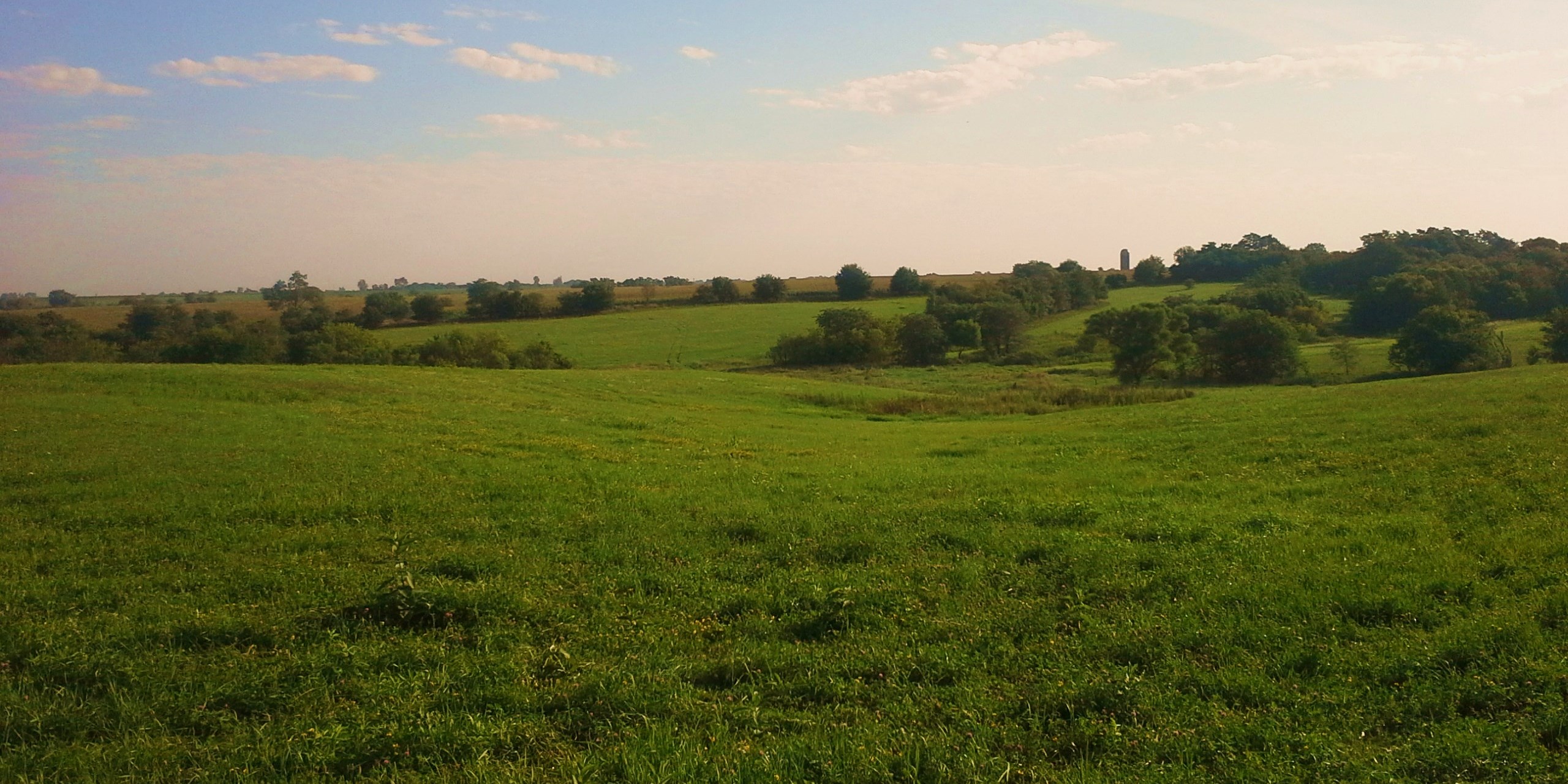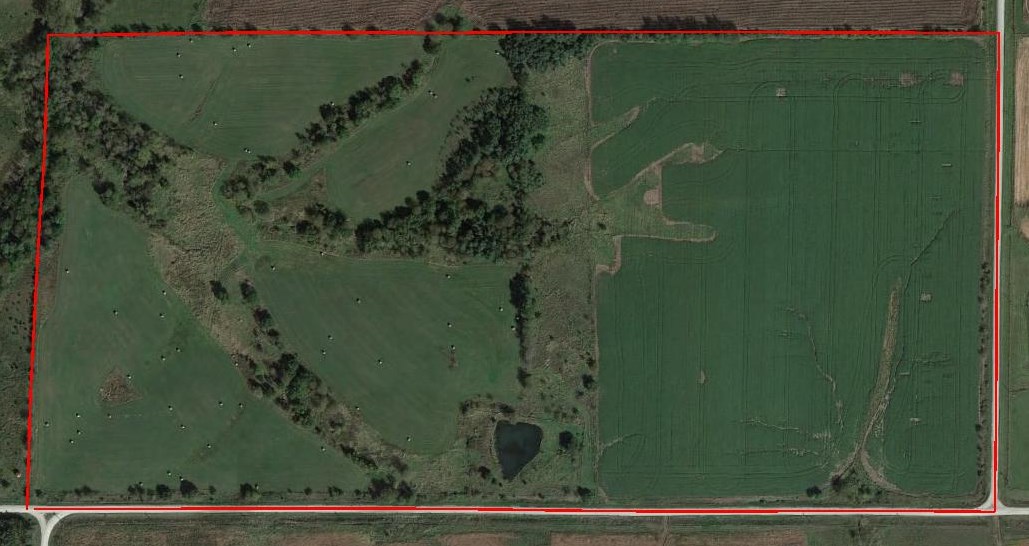Hunt 365, March 2017 Buying Recreational Land, Part III (A version of this article is published in the March issue of Iowa Sportsman Magazine)

Buying your own farm will make for a lifetime of great memories and a great investment as well. This was my first view of our newest farm…I liked what I saw right from the beginning.
When you are buying any investment, the most important part about the “buy” is not letting your emotions get the best of you. Our emotions can get us to think we need something we really don’t. They can get us to believe what we know isn’t true because we’ll talk ourselves into it…whatever it might be. Removing your emotions from an investment deal is hard to do, especially when that investment deal is buying recreational hunting land. Visions of lush food plots, thick draws, scrape lines, giant rubs, all leading to that inevitable monster buck! Preventing our emotions from getting in the way of a good decision to buy or not is harder than you might think. Nobody wants to ever admit to themselves that they’ve been suckered.
In preparing for this article on avoiding mistakes, hype, and emotional tricks, I went back and looked at all the farms I considered over the past six or seven years. I reviewed emails from past realtors, past listing brochures, and even did a current listing search for a new farm. The buyer traps are there if you’re willing to put your paws and check book in them. To be clear, there’s no trick in getting a fair price and a farm you can hunt for years to come. It takes time and work. In the past two articles I talked about what to look for in a farm from a hunting and economic standpoint. Now, we dive head first into avoiding mistakes!
The “Turn Key” there is a giant buck behind every tree…farm!
They’re out there. The farms that no matter how bad a hunter you are, you are still basically guaranteed a giant most years (sarcasm)! Farm listings targeting hunters could sound like this:
“These farms located in the heart of managed ground like this don’t last long”. The impression here is move fast, or this farm could be gone. Don’t take the bait! Even if this farm sells before you do your homework, it probably just means that someone else let their emotions get the best of them. This is literally the used car sales pitch from all eternity…I can’t believe realtors are still using this? I’m not saying to intentionally drag your feet, but if a farm gets sold before you get a chance to thoroughly check it out, don’t sweat it. It takes some time to gather data and walk a farm. I walked a farm I was interested in once (this is so bad you won’t believe me) and literally that day the listing agent calls me and says he is showing the farm to two more buyers the next day. The next day! Come on! It’s not like it was a new listing; it was on the market for almost half a year.
“This farm has been highly managed for the past 5 years. In just the past two years, two bucks scoring over 180” have been shot within a mile of this property”. How can one realtor possibly know all the ground in a 4 county radius and what has been managed? If my hunting party shoots every buck we see, isn’t that technically still a farm that’s managed…just probably not the way you want. I remember at one point in my searches for my second farm in Iowa, one realtor over a period of a couple years proclaimed that virtually every listing they had was in a great area. One by one, when each listing came out, you could bet that yes, once again the listing was in yet another great area surrounded by managed properties. Is that possible? Of course it’s not possible but it is their job to sell. To all this I say…buyer beware. And, how would you ever know if any of it is true? Pictures of giant bucks on trail cameras, hero shots of hunters behind big bucks, giants rubs, beaten down deer trails. I don’t hold any of this against a listing agent…just remember that it is their job to SELL the listing for their clients.
When I bought my second Iowa farm, the listing didn’t say much about the great whitetail hunting in the area. In fact, it didn’t mention the whitetail hunting at all. Or the fact that it was actually in a great neighborhood. The listing featured the farm’s income (which it had) and pointed out the possibility of good quail and pheasant hunting (there are no pheasants on my farm). It advertised timber (it has none worth anything). I’m guessing the listing agent never walked the farm since the pictures were all from the road…and had they walked the farm they would have found the giant rubs that I found when I walked it and included those in the listing. The farm most definitely does not have the look on an aerial photo of a great whitetail farm…which is why the listing agent probably didn’t proclaim “This farm is in a great managed area, hurry up before it’s gone!”. The only reason I knew the farm was truly in a great area with some super hunting on it is because I had done my own homework.
The high income, so high that it will pay for itself…farm!

My newest farm is 80 acres in size and mostly tillable. Don’t be fooled into thinking there isn’t good hunting here! The tillable gives me great income making the purchase possible, and because I did my homework, I know there are great bucks in and around this farm. With some effort, this farm will be a giant buck killing dream farm.
It actually used to be the case that you could find a farm that had enough income on it to make payments for you once you made the down payment. I think those days are probably mostly gone unless you have a huge down payment. Income is a huge part of making a farm affordable for most hunters because they can combine their hobby and interest in owning land with a pretty good investment. So here are some traps to avoid when considering income on a farm you want to buy.
“The farm currently has $4,000 annual income from a CRP contract expiring next year. Income could double with new CRP rates”. This would most likely be a true statement, but the key here is the word could. There is never a guarantee that there will be a new sign up or extensions in the future for CRP. And while we are on CRP, if you buy a farm with expiring CRP and it hasn’t been taken care of, there is a good chance it wouldn’t even qualify for CRP. I looked at a great farm once that had tons of income on it from CRP…only there were thousands of junipers growing in it meaning two things…either I would have to pay to remove all those trees or it would never qualify for re-enrollment. If expiring conservation programs cannot be renewed, the only income you have after that is through farm rent. Make sure CRP or other conservation income land is still quality farm ground in case you have to rent it out.
“The seller has agreed to rent back the tillable ground at $250/acre.” This was always a tricky statement or selling point for me to get my head around…and here’s why. Let’s suppose the farmer selling the property agrees to rent back the tillable acres at what was advertised for the next year. If the ground is really only worth $170/acre that could really impact the long term investment return. Let’s say there are 50 tillable acres. At the $250/acre rate, that’s income of $12,500 each year. You may have planned on this income for making payments. If after the first year, the farmer does not want to renew the lease, and you realize the going rate will only get you $170/acre, now you’re looking at $8500 annual income. That’s a big difference! When I value income potential in my searches I look at county average rates, potential CRP payments, and the quality of the tillable itself (CSR number) and base my calculations on that. If I get more, that’s a bonus but I don’t want to set myself up for future disappointments. While we are talking about farm rent, it is always a good idea to request the crop history of the farm. If there is no crop history you won’t qualify for CRP (if that’s something you might want). No crop history might also mean the farm doesn’t have quality ground or it has been pastured for a long time. Farm rent for pasture is significantly lower than row crop rents and deer hunting on ground that is pastured has major drawbacks. I’ve seen farms that have been pastured for a very long time get turned into row crop ground simply to make a listing look better. In some cases, the tillable ground is good; in other cases there was a reason it was in pasture in the first place!
I have tried to point out things to avoid, or rather things to make yourself aware of so that you don’t fall into an emotional trap and buy something you’ll regret in the future. I hope you don’t see this article as a bashing all realtors article…because that is not the intent. It is simply a listing agent’s job to sell the property at the highest price they can get for their client and for their commission. If you have unlimited money none of this is much concern for you; however, if you have saved your whole life to finally be in a position to buy a recreational farm you might need all the help you can get to make sure you get a fair deal.
If I had to give one piece of advice to any hunter in the market for their first farm, it would be to start your process by just looking for at least 6 months. Make some calls, walk a couple farms, but with no real intent to buy. Run the full gambit on a couple farms…calculate the income, request crop histories, look at the CSR2 values of the tillable, and get out and walk them. Once you have done this a few times it is easier to remove your emotions from the process. Plus, you’ll have gained valuable experience in sifting through all the details. With any luck, you’ll land a great realtor who can advocate on your behalf and help you through the process.
Next month, we are getting back to habitat improvements for your property. I’ve been talking a lot lately with other hunters about the benefits of hinge cutting. Late winter is a great time to put hinge cutting to work for you. I’ll go over why and how!
